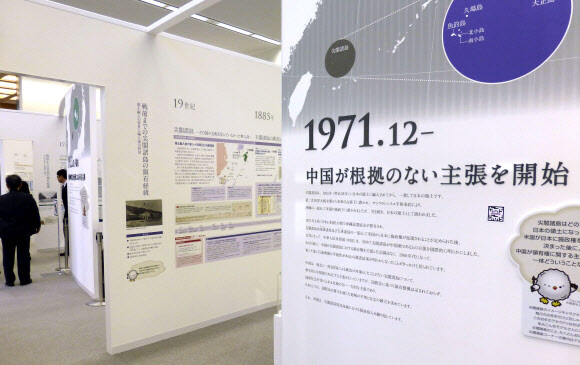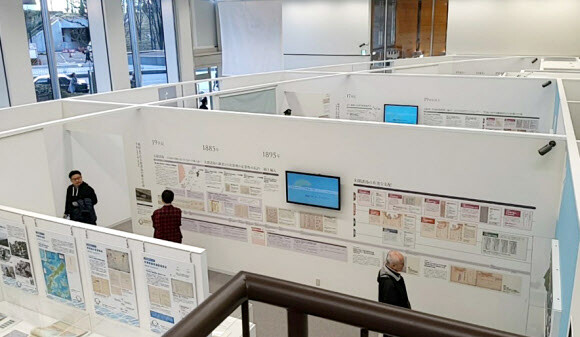hankyoreh
Links to other country sites 다른 나라 사이트 링크
[Column] The false ideas promoted by Japan’s new “territory museum”

After holding a ribbon-cutting ceremony at the new location of the National Museum of Territory and Sovereignty on Jan. 20, the Japanese government plans to open it to the public on Jan. 21. Tokyo set the museum up back in January 2018, with the goal of swaying public opinion about Dokdo (the Korean name for a pair of islets known internationally as the Liancourt Rocks and as Takeshima in Japan) and other disputed territories. Despite being located in downtown Tokyo, it didn’t get very many visitors. This led staff to complain that the museum wasn’t easy to find, given its basement location, and that it’s exhibition space was too limited.
In apparent recognition of such complaints, the museum was relocated to the neighborhood of the Japanese Diet and government agencies, which receives more foot traffic. The exhibition hall is now located at ground level, occupying seven times the original space. While the previous museum only displayed information about Dokdo and the Senkaku Islands (called the Diaoyudao Islands in China), the new museum also covers the Southern Kuril Islands. Museum staff hope to link up with the Japan Institute of International Affairs (JIIA), located in the same building, to take advantage of the institute’s research findings.
The National Museum of Territory and Sovereignty is operated by the Cabinet Secretariat’s Office for Planning and Coordinating Measures for Territory and Sovereignty. This office is advised by a group of experts on territory and publicity that was set up under the minister responsible for territorial issues to influence public opinion, both at home and abroad. The museum is one of the group’s territory-related research, education, and publicity projects. Importantly, the new museum features more videos and hands-on activities, aimed at disseminating its views to a larger number of young people, including those still in school.

However, the documents on display at the museum don’t seem to include an 1877 order by Japan’s Daijo-kan (Great Council of State) in which the Japanese government clarified that Dokdo didn’t belong to Japan. The only documents exhibited are those deemed favorable to the government’s position. For the most part, these were drafted after Japan’s decision to annex Dokdo in 1905 and after the Treaty of San Francisco was signed in 1951.
But it only takes a little digging in these documents to reach the truths of history. In 1905, during the Russo-Japanese War, Japan secretly and illegally incorporated Dokdo as Japanese territory and built a lookout post there for use during the war. Dokdo was an important strategic base for the Japanese navy. After the war, the Japanese press described Dokdo as a major military landmark. Meanwhile, Japanese fishermen were pushing for exclusive rights to catch sea lions in the area.
Taking advantage of the chaos in Joseon (as Korea was known at the time) at the end of the 19th century, the Japanese illegally moved to Ulleung Island, near Dokdo, where they caused havoc and even installed Japanese police officers in 1902. Since the Japanese were making themselves at home on Ulleung Island, there was nothing to stop them from doing as they pleased with Dokdo. Disregarding this history, the Japanese exhibits pretend that Dokdo was controlled peacefully and effectively after 1905.
In 1945, the Japanese were expelled from the Korean Peninsula and its surrounding islands following their unconditional surrender in World War II. The allied forces that ruled Japan after 1945 also removed Dokdo from the area of Japan’s control. Korean fishermen continued to effectively use and manage Dokdo. But when the MacArthur Line, which set a limit on Japanese fishing activities, was about to be revoked in 1952, the South Korean government hastily announced the Syngman Rhee Line, also known as the Peace Line. This was a self-defense measure, taken during the crisis of the Korean War, and aimed at preserving South Korean territory.
Japan claims S. Korea’s occupation of Dokdo is illegalJapan claims that South Korea’s occupation of Dokdo is illegal, citing as evidence the declaration of the Syngman Rhee Line. But South Korean control of Dokdo didn’t begin with that declaration; indeed, the islets were already under Korean control at that point. If anything, Japan took advantage of the confusion of the Korean War to send Coast Guard ships that committed illegal acts, including an attempt to chase Korean fishermen away from Dokdo and exploit the fishing grounds near the islets for themselves. Fortunately, the residents of Ulleung Island took it upon themselves to organize a volunteer force that successfully defended the islets.
These are just some of the historical distortions at Japan’s National Museum of Territory and Sovereignty, which displays documents that are carefully curated to reinforce its position. The museum can be truly described as a concerted act of collective hypnosis. The opening of the new facility is a sad development not only for South Korea-Japan relations, but also for the Japanese public, and it ought to be shut down.
By Hong Seong-geun, researcher at the Northeast Asian History Foundation
Please direct comments or questions to [english@hani.co.kr]

Editorial・opinion
![[Column] Welcome to the president’s pity party [Column] Welcome to the president’s pity party](https://flexible.img.hani.co.kr/flexible/normal/500/300/imgdb/original/2024/0515/3917157400447943.jpg) [Column] Welcome to the president’s pity party
[Column] Welcome to the president’s pity party![[Editorial] Korea must respond firmly to Japan’s attempt to usurp Line [Editorial] Korea must respond firmly to Japan’s attempt to usurp Line](https://flexible.img.hani.co.kr/flexible/normal/500/300/imgdb/original/2024/0514/2317156736305813.jpg) [Editorial] Korea must respond firmly to Japan’s attempt to usurp Line
[Editorial] Korea must respond firmly to Japan’s attempt to usurp Line- [Editorial] Transfers of prosecutors investigating Korea’s first lady send chilling message
- [Column] Will Seoul’s ties with Moscow really recover on their own?
- [Column] Samsung’s ‘lost decade’ and Lee Jae-yong’s mismatched chopsticks
- [Correspondent’s column] The real reason the US is worried about Chinese ‘overcapacity’
- [Editorial] Yoon’s gesture at communication only highlights his reluctance to change
- [Editorial] Perilous stakes of Trump’s rhetoric around US troop pullout from Korea
- [Guest essay] Preventing Korean Peninsula from becoming front line of new cold war
- [Column] The state is back — but is it in business?
Most viewed articles
- 1[Editorial] Transfers of prosecutors investigating Korea’s first lady send chilling message
- 2[Column] Welcome to the president’s pity party
- 3Unexpected rate of AI development requires timely discussion of side effects
- 4Could Korea’s Naver lose control of Line to Japan?
- 5US has always pulled troops from Korea unilaterally — is Yoon prepared for it to happen again?
- 6Korean opposition decries Line affair as price of Yoon’s ‘degrading’ diplomacy toward Japan
- 7Nuclear South Korea? The hidden implication of hints at US troop withdrawal
- 8Major personnel shuffle reassigns prosecutors leading investigations into Korea’s first lady
- 9Second suspect nabbed for gruesome murder of Korean in Thailand, 1 remains at large
- 10Korea cedes No. 1 spot in overall shipbuilding competitiveness to China